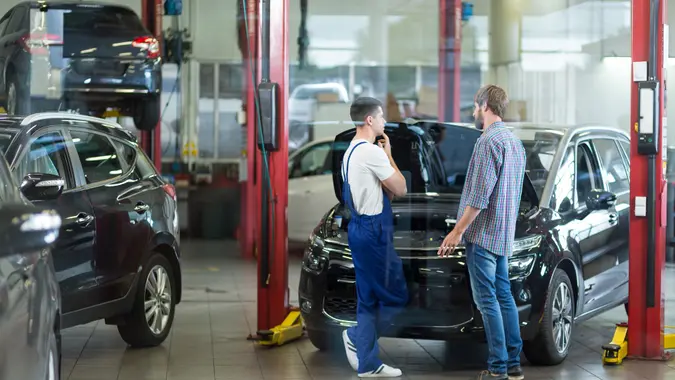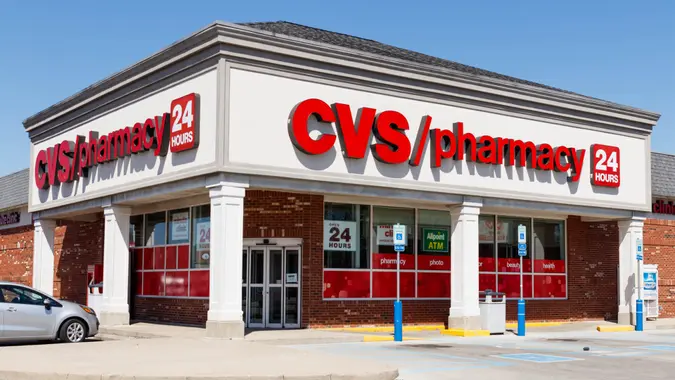Suze Orman: Avoid This Huge Car Buying Mistake

Commitment to Our Readers
GOBankingRates' editorial team is committed to bringing you unbiased reviews and information. We use data-driven methodologies to evaluate financial products and services - our reviews and ratings are not influenced by advertisers. You can read more about our editorial guidelines and our products and services review methodology.

20 Years
Helping You Live Richer

Reviewed
by Experts

Trusted by
Millions of Readers
The cost of car ownership in the U.S. is higher than ever, thanks to a few factors, including sky-high interest rates. As of December 2023, the average price for a new car was $48,759, according to Cox Automotive. Used cars are also expensive, sporting an average price of $25,638, according to Cox.
Unfortunately, you can make an already incredibly expensive purchase even more expensive — and stressful. Suze Orman recently took to her blog to warn Americans about a “huge car buying mistake” and urge them to avoid it. People who have auto loans or are considering one need to listen up to dodge this potential money pit.
People Are Taking Out Loans on Top of Loans for Cars
Orman read a recent report from Edmunds.com that found that 20% of people who bought a new car in the Q3 of 2023 and traded in their existing car, still owed money on the loan for the car they previously owned — even after getting the trade-in value.
“That is what is known as being ‘underwater,’ ‘upside-down’ or having ‘negative equity,'” Orman wrote. “And it’s not typically a small sum. Edmunds says the average negative equity for people with car loans is more than $6,000 these days.”
In and of itself, owing more on a car loan that the car’s current market value isn’t great. However, it’s not all that bad provided you’re making timely payments so that eventually, you’ll owe less than the current market value.
The problem as Orman sees it, though, is taking on more car debt when you already have preexisting car debt that has not been resolved.
“My problem is if you are upside down and you decide to buy another car and roll over the unpaid loan balance on the old car into a new loan for the new car,” Orman said. “This is where I think you are drifting into the financially dishonest lane.”
Cars Are Not Good Investments, So Buy What You Need — Not What You Want
Most new cars plummet in value as soon as you drive them off the lot. They’re bad investments, and shouldn’t even be thought of as an investment the way a house is. So, getting into piles of debt over what is inherently a money-losing situation is a really bad idea.
“You will never recoup the cost of what you paid,” Orman wrote. “Especially if you used a loan to finance the purchase. The goal should always be to pay the least amount possible to meet your need for a car. If you intend to take out a loan, it is beyond dishonest to buy the more expensive car that you want and not the car that you need that will cost you less.”
Don’t Make Matters Worse
Orman refers to buying new cars and trading them in with negative equity as “doubling down on a financial mistake.”
“The goal is to get a car loan paid off ASAP and drive it for years without owing a payment,” Orman penned. “When you buy a new car and roll over negative equity for an old car you are taking on more debt and extending the time you will be repaying the loan.”
Buyer Beware: Dealerships May Try To Convince You To Do This
The takeaway: Don’t take out a loan for a new car when you’ll still end up owing on your previous loan after the current trade-in value. And be prepared to stick to your guns even if professionals at the car dealership are trying to persuade you.
“Please don’t listen to the finance folks at a car dealership,” Orman wrote. “Of course they will tell you it is no problem to roll over the remaining balance on your current car loan into a new car loan. As long as you qualify for a loan, they could care less if this is a financially smart move. All they care about is selling you the new car.”
She concluded, “I care about your long-term financial security. Don’t fall for the pitch to trade in a car with negative equity. Just because it’s doable, doesn’t mean it is smart.”
More From GOBankingRates
- Nearly 1 in 3 Americans Hit by a Costly Holiday Scam, Norton Survey Shows -- How To Avoid This
- Here's What Retirees Wasted the Most Money On in 2025 -- and How To Avoid It in 2026
- How Middle-Class Earners Are Quietly Becoming Millionaires -- and How You Can, Too
- 6 Safe Accounts Proven to Grow Your Money Up to 13x Faster
 Written by
Written by  Edited by
Edited by 

























